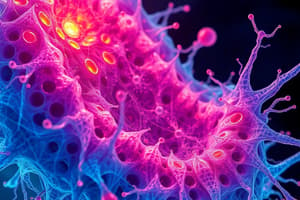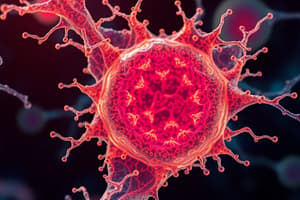Podcast
Questions and Answers
What term did Robert Hooke use to describe the structures he observed in the cork?
What term did Robert Hooke use to describe the structures he observed in the cork?
- Cells (correct)
- Pores
- Microsomes
- Compartments
Which of the following best describes why the onion peel should be kept in water before observing it under a microscope?
Which of the following best describes why the onion peel should be kept in water before observing it under a microscope?
- To prevent it from folding or drying out (correct)
- To enhance its color
- To soften the cell walls
- To allow better light penetration
What should be done after placing the onion peel on the glass slide?
What should be done after placing the onion peel on the glass slide?
- Place it under high power immediately
- Add a drop of oil
- Expose it to sunlight
- Cover it with a cover slip (correct)
In the experimental setup described, what is the purpose of the safranin solution?
In the experimental setup described, what is the purpose of the safranin solution?
What significant historical feat is associated with Robert Hooke's observations in 1665?
What significant historical feat is associated with Robert Hooke's observations in 1665?
What did Robert Hooke first observe that led to the discovery of cells?
What did Robert Hooke first observe that led to the discovery of cells?
Which biologist is credited with establishing the modern cell theory along with Schwann?
Which biologist is credited with establishing the modern cell theory along with Schwann?
What major component of a cell was discovered by Robert Brown in 1831?
What major component of a cell was discovered by Robert Brown in 1831?
What structure is found in every eukaryotic cell?
What structure is found in every eukaryotic cell?
What significant advancement allowed for the observation of cell organelles in detail?
What significant advancement allowed for the observation of cell organelles in detail?
Flashcards are hidden until you start studying
Study Notes
Discovery of Cells
- Robert Hooke discovered cells in 1665 by examining cork under a self-designed microscope.
- He described cells as tiny compartments resembling a honeycomb, deriving the term from the Latin word for 'little room'.
- This discovery marked a significant milestone in biology, establishing that living things consist of individual units known as cells.
Historical Contributions to Cell Biology
- Antonie van Leeuwenhoek discovered free-living cells in pond water in 1674 using improved microscopes.
- Robert Brown identified the nucleus within cells in 1831.
- Purkinje coined the term 'protoplasm' (1839) to describe the cell's fluid substance.
- Schleiden (1838) and Schwann (1839) formulated the cell theory, stating that all organisms consist of cells and that the cell is the basic unit of life.
- Virchow (1855) expanded the cell theory, asserting that all cells arise from pre-existing cells.
- The advent of the electron microscope in 1940 provided deeper insights into cell structure.
Cell Structure and Organization
- Cells are primarily composed of three components: plasma membrane, cytoplasm, and nucleus.
- Each of these components plays a crucial role in maintaining cellular functions and interactions with the environment.
Plasma Membrane
- The plasma membrane is the outermost layer that controls the movement of substances into and out of the cell, termed selectively permeable.
- Substances enter and exit by diffusion, moving from high to low concentration areas (e.g., CO2 and O2).
- Osmosis is a specific form of diffusion that refers to the movement of water across a selectively permeable membrane.
Types of Solutions Affecting Cells
- Hypotonic solutions cause cells to swell by gaining water.
- Isotonic solutions result in no net water movement, maintaining cell size.
- Hypertonic solutions cause cells to shrink due to water loss.
Cell Wall
- Plant cells have an additional rigid layer called the cell wall, composed mainly of cellulose, providing structural support.
- Plasmolysis occurs when a plant cell loses water, causing the contents to shrink from the cell wall.
Nucleus
- The nucleus, typically centralized, has a double-layered nuclear membrane with pores for material transfer.
- Contains chromosomes composed of DNA, which carry hereditary information.
- Nucleus plays a central role in cell reproduction and development.
Prokaryotic vs. Eukaryotic Cells
- Prokaryotic cells lack a defined nucleus and membrane-bound organelles; they possess a nucleoid instead.
- Eukaryotic cells have a well-defined nucleus and various membrane-enclosed organelles.
- Differences in size, genetic organization, and organelle presence distinguish the two cell types.
Cytoplasm and Organelles
- Cytoplasm is the fluid within the cell containing organelles, which perform specific functions.
- Organelles are membrane-bound structures critical for cellular processes (e.g., endoplasmic reticulum, Golgi apparatus).
Endoplasmic Reticulum (ER)
- The ER is a network of membranes, divided into rough ER (with ribosomes for protein synthesis) and smooth ER (for lipid synthesis).
- Functions include transport of materials and serving as a cytoplasmic framework.
Golgi Apparatus
- Composed of membrane-bound vesicles and responsible for packaging, modifying, and dispatching materials synthesized near the ER.
- Involved in the storage and transformation of complex sugars from simpler ones.
Activities for Understanding
- Observing onion and cheek cells under a microscope highlights various cellular structures and their staining with iodine or safranin.
- Conducting experiments with osmosis using eggs or dried fruits illustrates the principles of water movement across cell membranes.### Golgi Apparatus and Lysosomes
- The Golgi apparatus plays a role in the formation of lysosomes.
- Lysosomes are membrane-bound sacs containing digestive enzymes produced by the rough endoplasmic reticulum (RER).
- They function as the cell's waste disposal system, digesting foreign materials and worn-out organelles.
- Enzymes in lysosomes are capable of breaking down organic material into simpler substances.
- Lysosomes may burst during cellular metabolism disturbances, leading to self-digestion, earning them the nickname "suicide bags."
Mitochondria
- Mitochondria, known as the cell's "powerhouses," have two membrane layers: a smooth outer membrane and a folded inner membrane called cristae.
- The inner membrane folds increase surface area, facilitating ATP (Adenosine triphosphate) production, the energy currency of the cell.
- ATP provides energy for new chemical compound synthesis and mechanical work.
- Mitochondria contain their own DNA and ribosomes, allowing them to synthesize some of their proteins.
Plastids
- Plastids are exclusive to plant cells and come in two types: chromoplasts (colored) and leucoplasts (colorless).
- Chloroplasts, a type of chromoplast, contain chlorophyll and are crucial for photosynthesis.
- Leucoplasts store food in the form of starch, oils, and proteins, primarily in plant cells.
- Plastids have a structure similar to mitochondria, with many membranes and their own DNA and ribosomes.
Vacuoles
- Vacuoles serve as storage organelles, with animal cells having smaller vacuoles compared to the large central vacuole in plant cells.
- The central vacuole in plant cells can occupy 50-90% of the cell's volume, aiding in storage and maintaining cell structure.
Cell Division
- Cell division produces new cells for growth, repair of damaged tissues, and reproduction.
- Two main types of cell division are mitosis (for growth) and meiosis (for producing gametes).
- Mitosis results in two identical daughter cells with the same chromosome number as the mother cell.
- Meiosis involves two divisions, resulting in four new cells with half the chromosome number of the mother cell.
Cell Structure and Function
- Cells are the basic organizational unit of life, enclosed by a plasma membrane made of lipids and proteins.
- The cell membrane regulates material movement between the cell and the environment.
- Plant cells possess a cellulose cell wall, allowing them to survive in hypotonic conditions without bursting.
- The nucleus, surrounded by a double-layered membrane in eukaryotes, directs cellular life processes.
- The endoplasmic reticulum (ER) aids intracellular transport and serves as a manufacturing site.
- The Golgi apparatus modifies, stores, and packages substances produced by the cell.
- Most plant cells contain plastids that play roles in pigment storage and food synthesis.
Studying That Suits You
Use AI to generate personalized quizzes and flashcards to suit your learning preferences.




